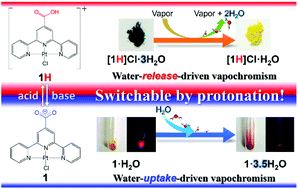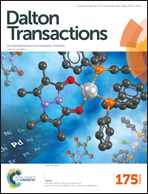Proton-switchable vapochromic behaviour of a platinum(ii)–carboxy-terpyridine complex†
Abstract
We synthesized a carboxy-substituted Pt(II)–terpyridine complex, i.e. [PtCl(Hctpy)]Cl ([1H]Cl; Hctpy = 4′-carboxy-2,2′:6′,2′′-terpyridine), that shows interesting switchable vapochromic behaviour upon protonation/deprotonation of the carboxy group. The as-synthesized dark-blue amorphous-like solid [1H]Cl·3H2O was converted to a yellow crystalline solid, [1H]Cl·H2O, upon exposure to various polar organic solvent vapours (e.g., acetonitrile, ethanol, 1-propanol, and dichloromethane), which promote the removal of water molecules. The reaction of [1H]Cl·3H2O with aqueous ammonia afforded a deprotonated bright-yellow crystalline complex, i.e. [PtCl(ctpy)]·H2O (1·H2O), which exhibits red luminescence with an emission maximum at 622 nm. Although the colour of 1·H2O was not affected by exposure to various polar organic solvent vapours, interesting vapochromic luminescence with a remarkable red-shift of the emission maximum from 622 to 652 nm was observed upon exposure to saturated water vapour to form orange crystalline 1·3.5H2O. X-ray structural analysis revealed that the planar and neutral complex molecule 1 forms a one-dimensional columnar structure with an intermolecular Pt⋯Pt distance of 3.518(2) Å in the orange crystalline 1·3.5H2O, while the cationic molecule [1H]+ in the protonated form, [1H]Cl·H2O, generates a dimeric structure with an intermolecular Pt⋯Pt distance of 3.439(2) Å. This difference suggests that the vapochromic behaviours of the protonated and deprotonated forms could be caused by structural changes induced by water-vapour adsorption/desorption, which affect the intermolecular Pt⋯Pt distance, thereby changing the energy of the metal–metal-to-ligand charge-transfer (MMLCT) transition. These contrasting results for the protonated and deprotonated complexes clearly indicate that the hydrophilicity of complex 1 is significantly affected by protonation/deprotonation of the carboxy group. In addition, quasi-reversible conversion between [1H]Cl·3H2O and 1·H2O was achieved by exposure of the protonated and deprotonated forms to triethylamine and humid hydrochloric acid vapours, respectively.


 Please wait while we load your content...
Please wait while we load your content...